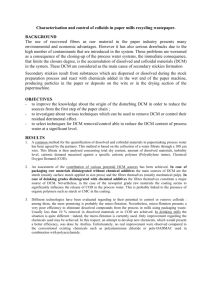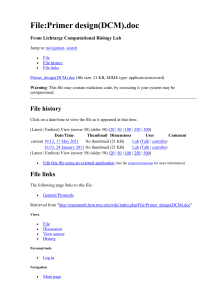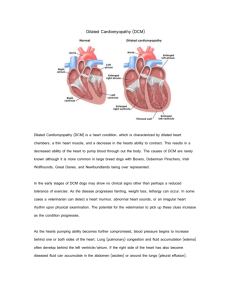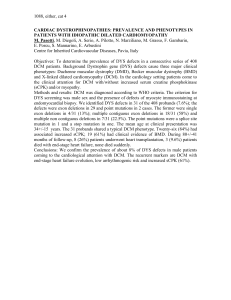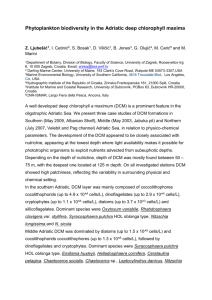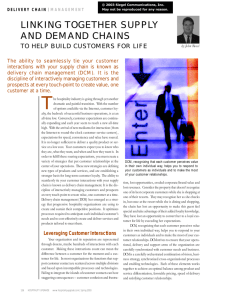Dynamic Causality Modelling
advertisement
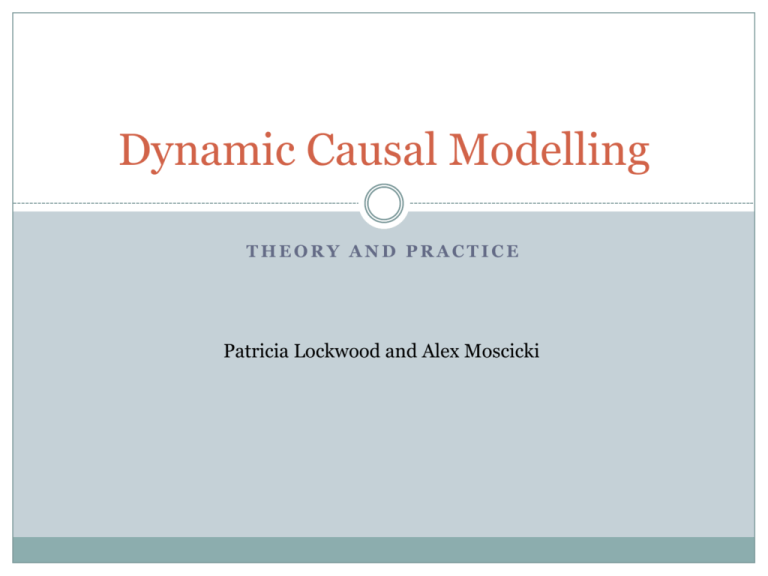
Dynamic Causal Modelling
THEORY AND PRACTICE
Patricia Lockwood and Alex Moscicki
Theory
Why DCM?
What DCM does
The State Equation
Application
Planning DCM studies
Hypotheses
How to complete in SPM
Brains as Systems
Background to DCM
“DCM is used to test the specific hypothesis that motivated the
experimental design. It is not an exploratory technique […]; the results
are specific to the tasks and stimuli employed during the experiment.”
[Friston et al. 2003 Neuroimage]
Connectivity analyses
Whole time
series
Not causal
Causal
Condition
specific
FUNCTIONAL
CONNECTIVITY
PSYCHOPHYSICAL
INTERACTIONS
Classical
inferential
P(Data)
STRUCTURAL
EQUATION MODELLING
DYNAMIC CAUSAL
MODELLING
Bayesian
P(Model)
Model evidence = Model fit – model complexity
Key features of DCM
DCM is a generative model
= a quantitative / mechanistic description of how observed data are generated.
1- Dynamic
2- Causal
3- Neuro-physiologically motivated
4- Operate at hidden neuronal interactions
5- Bayesian in all aspects
6- Hypothesis-driven
7- Inference at multiple levels.
How do we do DCM?
Create a neural model to represent our
hypothesis
2. Convolve it with a haemodynamic model to
predict real signal from the scanner
3. Compare models in terms of model fit and
complexity
1.
The Neural Model for the state equation
Recipe
z4
Z - Regions
z2
z3
z1
The Neural Model
Recipe
z4
z2
z3
z1
Z - Regions
A - Average
connections
The Neural Model
Attention
Recipe
z4
z2
z3
z1
Z - Regions
A - Average
connections
B - Modulatory
Inputs
The Neural Model
Attention
Recipe
z4
z2
z3
z1
Z - Regions
A - Average
Connections
B - Modulatory
Inputs
C - External
Inputs
m
z ( A u j B ) z Cu
j
j 1
“C”, the direct or driving effects:
- extrinsic influences of inputs on neuronal activity.
“A”, the endogenous coupling or the latent connectivity:
- fixed or intrinsic effective connectivity;
- first order connectivity among the regions in the absence of input;
- average/baseline connectivity in the system (DCM10/DCM8).
“B”, the bilinear term, modulatory effects, or the induced
connectivity:
- context-dependent change in connectivity;
- eq. a second-order interaction between the input and activity in a
source region when causing a response in a target region.
[Units]: rates, [Hz];
Strong connection = an effect that is influenced
quickly or with a small time constant.
DCM Overview
Neural Model
Haemodynamic Model
4
2
3
1
e.g. region 2
x
=
DCM Overview
=
Region 2
Timeseries
u
The hemodynamic model
t
m
dx
A u j B( j ) x Cu
dt
j 1
• 6 hemodynamic
parameters:
{ , , , , , }
s x s γ( f 1)
f
[Friston et al. 2003, NeuroImage]
[Stephan et al. 2007, NeuroImage]
s
s
important for model
fitting, but of no interest
for statistical inference
• Area-specific estimates
(like neural parameters)
region-specific HRFs!
neural state equation
vasodilatory signal
h
• Empirically determined
a priori distributions.
inputs
flow induction (rCBF)
f s
f
changes in volume
τv f v
1 /α
v
Balloon
model changes in dHb
v
τq f E ( f,E0 ) qE0 v1/α q/v
q
S
q
V0 k1 1 q k2 1 k3 1 v
S0
v
k1 4.30 E0TE
( q, v )
k2 r0 E0TE
k3 1
BOLD signal
change equation
hemodynamic
state
equations
DCM: Methods and Practice
• Experimental Design and Motivation
– Simulated data
• How to conduct DCM in SPM
– A practical example and guide
– Basic steps
– Interpreting results
• Bayesian Model Selection
• Parameter estimates and group level statistics
Experimental Design and Motivation
– Can apply DCM to any design used in a GLM analysis
– If the GLM does not detect activation in a given region,
there is no motivation to include this region in a
(deterministic) DCM
– Deterministic DCM tests
generative models of
how the GLM data arose
Multifactorial Design
2x2 Design:
• One factor that varies the driving (sensory) input (e.g.
static or motion)
• One factor that varies the contextual or task input (e.g.
attention vs. no attention)
Stephan, K. DCM for fMRI (powerpoint presentation). SPM Course, May 13, 2011
Modeling interactions
The GLM analysis shows a main effect of stimulus in
region Z1 and a stimulus x task interaction in Z2
How might we model this using DCM?
Simulated data
z
1
S1
+++
Simulated
Stim
1
z1
Stim 2
+
Stim 1
z2
+++
Task A
+
S2
S1
S2
S1
S2
z
1
+
Task B
+
z1
Stim 2
S1
data
+
+++
+++
S2
+++
+++
Task A
z2
Task A
z
2
Task B
+
Task B
z
2
Stephan, K. DCM for fMRI (powerpoint presentation). SPM Course, May 13, 2011
DCM Practical Steps:
1. Seek an explanation for the GLM results
2. Specify inputs in design matrix
3. Extract time series from regions of interest
4. Specify model architecture (hypothesis driven)
5. Estimate the model
1. Repeat steps 2 and 3 for all models in model space
2. Compare models using Bayesian Model Selection (single
subject and group level)
Attention to motion in the visual system
Stimuli 250 radially moving dots
Parameters:
- blocks of 10 scans
- 360 scans total
- TR= 3.2 seconds
Contextual factor
4 Conditions
- fixation only
-observe static dots
-observe moving dots
-task (attention to) moving dots
Sensory input
No
attent
Attent.
static
motion
No motion/
attention
Motion /
no attention
Motion /
attention
SPM Manual (2011)
-fixation only – baseline
-observe static dots V1
-observe moving dots V5
-attention to moving dots
V5 + SPC
• GLM analysis showed
that motion activated
V5, but that attention
enhanced this activity.
Attention – No attention
PPC
V5
V5 activity
GLM Results
attention
no attention
V1 activity
Büchel & Friston 1997, Cereb. Cortex
Büchel et al. 1998, Brain
Driving input
• Photic: all visual input – static+
motion+ attention to motion
Modulatory input
• Motion
• Attention
Attention
Motion
Specify regressors for DCM as
driving inputs and modulators:
Photic
Modeling inputs in DCM analysis
Alternate Dynamic Causal Models
Model 1 (backward):
Model 2 (forward):
Time [s]
Defining models: Hypothesis driven // Compatibility // Size // Plausibility.
[Seghier (powerpoint pres.) ICN SPM Course, 2011; Seghier et al. 2010, Front Syst Neurosci]
Defining VOIs: time series extraction
V5 VOI
Transverse
Specifying the model
name
DCM button
In order!
In Order!!
Attention
to motion
static
Motion &
no attention dots
Estimate the model
V1
V5
PPC
observed
fitted
Bayesian Model
Comparison
Model evidence:
p( y | m) p( y | , m) p( | m) d
The log model evidence can be
represented as:
log p(y | m) = accuracy(m) -
Bayes factor:
complexity(m)
p( y | m i)
Bij
p( y | m j )
B12
p(m1|y)
Evidence
1 to 3
50-75%
weak
3 to 20
75-95%
positive
20 to 150
95-99%
strong
150
99%
Very strong
Penny et al. 2004, NeuroImage
Model evidence and selection
All models are
wrong, but
some are useful
-Box and Draper
[Pitt and Miyung 2002 TICS]
Review Winning Model and Parameters
Model 2:
attentional modulation
of SPC→V5
Parameter estimation
Photic
PPC
0.86 (100%)
1.25 (99%)
0.89
(99%)
-0.15
(100%)
V1
ηθ|y
.50
(100%)
0.75 (98%)
V5
Motion
1.50 (90%)
Attention
Maximum a posteriori estimate
of a parameter (MAP)
Inference about DCM parameters: Group level
FFX group analysis
• Likelihood distributions from
different subjects are
independent
• Subject assumed to use
identical systems
• One can use the posterior from
one subject as the prior for the
next
RFX group analysis
• Optimal models vary across
subjects
Separate fitting of identical models
for each subject
Selection of (bilinear) parameters of
interest
one-sample t-test:
parameter > 0 ?
Stephan et al. 2010, NeuroImage
Stephan, K. DCM for fMRI (powerpoint). SPM Course, May 13, 2011
ANOVA,
rmANOVA,
etc
paired t-test:
parameter 1 >
parameter 2 ?
definition of model space
inference on model structure or inference on model parameters?
inference on
individual models or model space partition?
optimal model
structure assumed to
be identical across
subjects?
yes
comparison of
model families
using
FFX or RFX BMS
inference on
parameters of an optimal model or
parameters of all models?
optimal model
structure assumed to
be identical across
yes subjects? no
no
FFX
BMS
FFX
BMS
BMA
RFX
BMS
Stephan et al. 2010, NeuroImage
FFX analysis of
parameter
estimates
(e.g. BPA)
RFX
BMS
RFX analysis of
parameter
estimates
(e.g. t-test,
ANOVA)
[Seghier et al. 2010, Front Syst Neurosci];
Seghier (powerpoint pres.) ICN SPM Course, 2011
DCM Summary
• Allows one to test mechanistic hypotheses about observed effects
• Generates a predicted time series using set of differential equations
to model neuro-dynamics and a forward hemodynamic model
• Operates at the neuronal level
• Uses a Bayesian framework to estimate model parameters by
optimally fitting the model’s predicted time-series to the observed
time series
• A generic approach to modelling experimentally perturbed dynamic
systems.
Thank you to our expert,
Mohamed Seghier!
References
• The first DCM paper: Dynamic Causal Modelling (2003). Friston et al. NeuroImage 19:1273-1302.
• Physiological validation of DCM for fMRI: Identifying neural drivers with functional MRI: an
electrophysiological validation (2008). David et al. PLoS Biol. 6 2683–2697
• Hemodynamic model: Comparing hemodynamic models with DCM (2007). Stephan et al. NeuroImage
38:387-401
• Nonlinear DCMs:Nonlinear Dynamic Causal Models for FMRI (2008). Stephan et al. NeuroImage
42:649-662
• Two-state model: Dynamic causal modelling for fMRI: A two-state model (2008). Marreiros et al.
NeuroImage 39:269-278
• Group Bayesian model comparison: Bayesian model selection for group studies (2009). Stephan et al.
NeuroImage 46:1004-10174
• 10 Simple Rules for DCM (2010). Stephan et al. NeuroImage 52.
• Seghier et al. (2010). Identifying abnormal connectivity in patients using dynamic causal modeling of
fMRI responses . Front Syst Neurosc.
• Dynamic Causal Modelling: a critical review of the biophysical and statistical foundations. Daunizeau
et al. Neuroimage (2010), in press
• SPM Manual, SMP courses slides, last years presentations.



